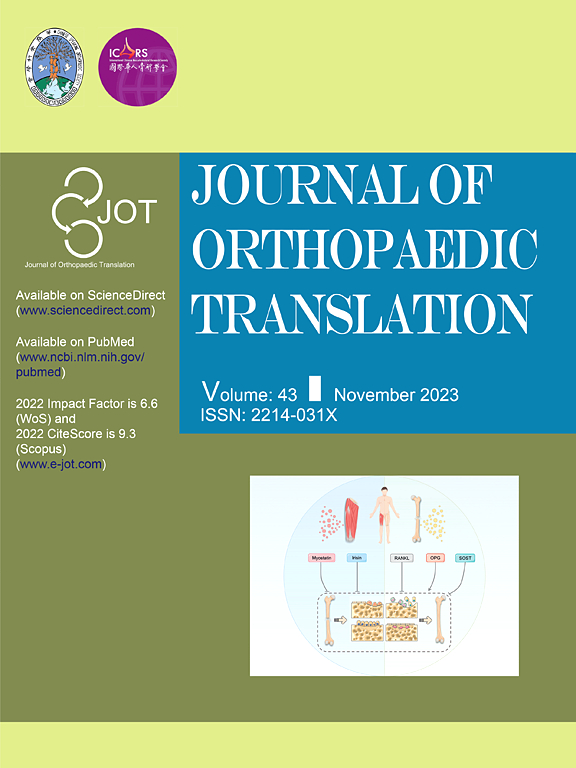纤维软骨透明化:关节纤维软骨的一种潜在治疗策略
IF 5.9
1区 医学
Q1 ORTHOPEDICS
引用次数: 0
摘要
关节纤维软骨常见于骨关节炎(OA)或软骨损伤的关节表面,常被视为软骨退变的结果。与透明软骨相比,纤维软骨表现出较差的力学性能和生物功能,这有助于软骨进一步退变和OA的进展。尽管如此,软骨再生的研究还没有充分解决与纤维软骨相关的具体挑战和策略。虽然纤维软骨的形成是软骨修复过程中不可避免的结果,但它在再生过程中提供了几个好处,如提供天然细胞来源和与周围组织建立强大的整合。最近,一种专注于原位修饰纤维软骨以促进透明软骨再生的治疗方法被提出,称为“纤维软骨透明化”。我们最近的工作已经证明了在受伤区域内将现有的纤维软骨转化为透明软骨的可行性。该策略的关键要素包括修饰细胞外基质(ECM)、靶向纤维化软骨细胞和改变局部微环境。本文综述了目前对关节纤维软骨的特性和机制的认识,同时讨论了纤维软骨透明化用于软骨再生的潜在方法和可行性。本文章由计算机程序翻译,如有差异,请以英文原文为准。

Fibrocartilage hyalinization: A potential therapeutic strategy for articular fibrocartilage
Articular fibrocartilage is commonly observed on the joint surface in osteoarthritis (OA) or cartilage injury, often seen as a result of cartilage degeneration. Compared to hyaline cartilage, fibrocartilage exhibits inferior mechanical properties and biological functions, which contribute to further cartilage degeneration and the progression of OA. Despite this, research on cartilage regeneration has not sufficiently addressed the specific challenges and strategies related to fibrocartilage. Although fibrocartilage formation is an unavoidable outcome during cartilage repair, it offers several benefits in the regeneration process, such as providing a natural cell source and establishing a strong integration with surrounding tissues. Recently, a therapeutic approach focused on the in-situ modification of fibrocartilage to promote hyaline cartilage regeneration, referred to as “fibrocartilage hyalinization”, has been proposed. Our recent work has demonstrated the feasibility of converting existing fibrocartilage into hyaline cartilage in vivo within the injured area. Key elements of this strategy include modifying the extracellular matrix (ECM), targeting fibrotic chondrocytes, and altering the local microenvironment. This review summarizes the current understanding of articular fibrocartilage's characteristics and mechanisms, while also discussing potential approaches and the feasibility of fibrocartilage hyalinization for cartilage regeneration.
求助全文
通过发布文献求助,成功后即可免费获取论文全文。
去求助
来源期刊

Journal of Orthopaedic Translation
Medicine-Orthopedics and Sports Medicine
CiteScore
11.80
自引率
13.60%
发文量
91
审稿时长
29 days
期刊介绍:
The Journal of Orthopaedic Translation (JOT) is the official peer-reviewed, open access journal of the Chinese Speaking Orthopaedic Society (CSOS) and the International Chinese Musculoskeletal Research Society (ICMRS). It is published quarterly, in January, April, July and October, by Elsevier.
 求助内容:
求助内容: 应助结果提醒方式:
应助结果提醒方式:


